Khadas VIM4 single board computer was first unveiled last October with Amlogic A311D2 octa-core Cortex-A73/A53 processor, 8GB LPDDR4X, but it’s only been launched today, and you can now buy the Khadas VIM4 board for right under $200.
It is an upgrade to Khadas VIM3 Pro launched with Amlogiv A311D hexa-core processor a few years ago, and our testing in Android 11 revealed the main benefit may be the upgrade GPU that delivered a 67% boost in 3DMark, but CPU multi-core performance and memory bandwidth will also see some benefits over Amlogic A311D, even against in overclocked systems like ODROID N2+.
Here’s a reminder of Khadas VIM4 specifications:
- SoC – Amlogic A311D2 octa-core processor with 4x Arm Cortex-A73 cores @ up to 2.2 GHz and 4x Cortex A53 cores @ up to 2.0 GHz, Arm Mali-G52 MP(8EE) GPU, (Note: no NPU at this time)
- System Memory – 8GB LPDDR4X @ 2016 MHz
- Storage – 32GB eMMC flash, 32MB SPI flash, microSD card slot, support for M.2 NVMe SSD via the New M2X expansion board
- MCU – STMicro STM32G031 Cortex-M0+ microcontroller @ 64 MHz for power management, customizations, and boot media configuration
- Video Outputs
- HDMI 2.1 up to 4Kp60
- 30-pin 0.5mm Pitch FPC Connector for 4-lane MIPI-DSI interface up to 1920 x 1080
- eDP interface
- LVDS and V-by-One interfaces
- Video Input – 1x Micro HDMI port up to 4Kp60
- Video
- Decoding
- 8Kp24 AV1, H.265, VP9
- Supports multi-video decoding up to 4Kx2K@60fps + 1x1080P@60fps
- HDR10, HDR10+, HLG, and PRIME HDR video processing
- Encoding – 4Kp50 H.265 / H.264 60fps decoder
- Decoding
- Audio – 8-ch I2S for microphone array applications over M2. connector
- Camera – FPC connector for 2x 4-lane MIPI CSI with dual camera support; 16MP ISP
- Connectivity
- Gigabit Ethernet with WoL support
- Dual-band 802.11a/b/g/n/ac/ax WiFI 6, 2X2 MIMO and Bluetooth 5.2 via Ampak 6275S module
- USB – 1x USB 3.0 Type-A port, 1x USB 2.0 type-A port, 1x USB 2.0 OTG type-C port
- Sensor – KXTJ3-1057 3-axis digital accelerometer
- Expansion
- M.2 Socket with single-lane PCIe 2.0, USB 2.0, I2S, I2C, ADC, 100M Ethernet PHY interface, GPIO, MCU_PA2
- 40-pins 2.54mm pitch header exposing:
- CPU signals – USB, I2C, I2S, SPDIF, UART, PWM, ADC
- MCU signals – SWIM, NRST, PA1
- Misc – RTC & battery header; 4-pin cooling fan header with PWM speed control; 3x user LEDs; power, function and reset buttons; XPWR pads for an external power button
- Power Supply – 5V to 20V via USB-C port or pogo pads
- Dimensions – 82.0 x 58.0 x 13 mm (4x M2 mounting holes)
My VIM4 board shipped with a heatsink and PWM fan that keeps it cool under load. It is turned off most of the time even in a room with a 28°C ambient temperature, and I found it very quiet when it is triggered under load.
The company also offers a variety of optional accessories, some of which you can find in our Khadas VIM4 unboxing:
- VIMs Heatsink
- 3705 Cooling Fan
- TS050 Touch Screen
- New M2X Extension board for M.2 SSD and/or M.2 4G LTE modem
- RTC Battery
- USB-C Adapter
- 4G Module
- 5G Module
- M2X WWAN
- VBO LCD Module
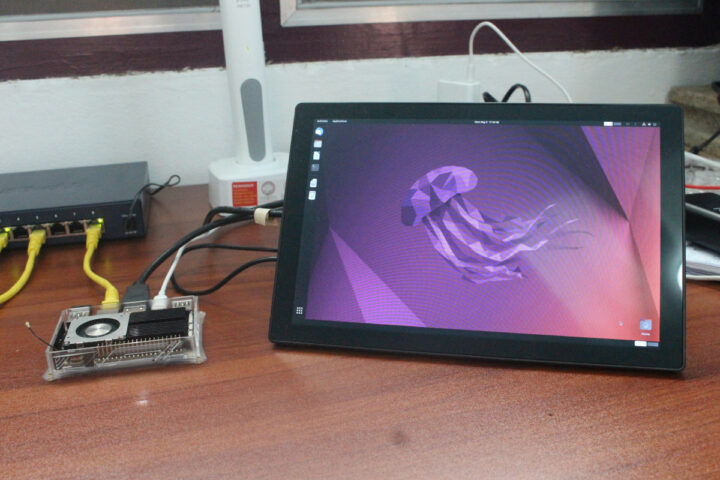
On the software side, Khadas VIM4 board supports the OOWOW system to easily download and install operating systems from the cloud, and currently lists Android 11, Ubuntu 22.04 Desktop, and Ubuntu 22.04 Server. The Android 11 OS is not designed for end-users with an image based on AOSP without services like Google Play, but it offers features like display orientation, micro HDMI input, Wake-on-LAN, and so on.
I’ve just installed Ubuntu 22.04 Desktop, and a full review is coming soon, but in the meantime, I ran sbc-bench.sh to compare it to the benchmark results I got with ODROID-N2+ (Amlogic A311D @ 2.4 GHz):
|
1 2 3 4 5 6 7 8 9 10 11 12 13 14 15 16 17 18 19 20 21 22 23 24 25 26 27 28 29 30 |
sudo /bin/bash ./sbc-bench.sh -c sbc-bench v0.9.4 Installing needed tools. This may take some time..../sbc-bench.sh: line 1328: : No such file or directory Done. Checking cpufreq OPP. Done (results will be available in 14-19 minutes). Executing tinymembench. Done. Executing OpenSSL benchmark. Done. Executing 7-zip benchmark. Done. Checking cpufreq OPP. Done (20 minutes elapsed). Memory performance (different CPU cores measured individually): memcpy: 7816.6 MB/s (0.2%) memset: 11717.9 MB/s memcpy: 2127.4 MB/s memset: 10588.1 MB/s 7-zip total scores (3 consecutive runs): 12016,12028,12132 OpenSSL results (different CPU cores measured individually): type 16 bytes 64 bytes 256 bytes 1024 bytes 8192 bytes 16384 bytes aes-128-cbc 340689.15k 881206.06k 1410492.07k 1649971.88k 1748642.47k 1754764.63k aes-128-cbc 149831.11k 461121.77k 943687.08k 1308184.58k 1472618.50k 1461382.04k aes-192-cbc 319216.09k 796967.81k 1195461.89k 1387976.70k 1458872.32k 1463440.73k aes-192-cbc 143651.73k 414755.01k 777326.76k 1012672.51k 1110059.69k 1117558.10k aes-256-cbc 309348.38k 723233.54k 1063064.92k 1197730.82k 1251726.68k 1255576.92k aes-256-cbc 139829.49k 384315.90k 677202.69k 849066.33k 916553.73k 921638.23k Full results uploaded to http://ix.io/3Xna. |
If we compare both platforms in graphical form, we can see the memory bandwidth is much higher in Khadas VIM4, the 7-zip multi-thread score is also significantly higher, but AES-256 16KB is slower probably because it is a single-threaded benchmark, and the Amlogic A311D2 Cortex-A73 cores run at 2.2 GHz, while the Amlogic S922X Cortex-A73 cores go up to 2.4 GHz in ODROID-N2+. With the CPU temperature never exceeding 58.2°C in sbc-bench benchmark, I suspect Khadas could also provide an image with higher DRAM timing if they wished to.
You can purchase the Khadas VIM4 board now for $199.90 on the company’s store. But that’s without the recommended heatsink and fan, so you may prefer going with the $219.90 “VIM4 Active Cooling Kit” instead. Those are promotional prices with a $20 discount until June 10, 2022.

Jean-Luc started CNX Software in 2010 as a part-time endeavor, before quitting his job as a software engineering manager, and starting to write daily news, and reviews full time later in 2011.
Support CNX Software! Donate via cryptocurrencies, become a Patron on Patreon, or purchase goods on Amazon or Aliexpress


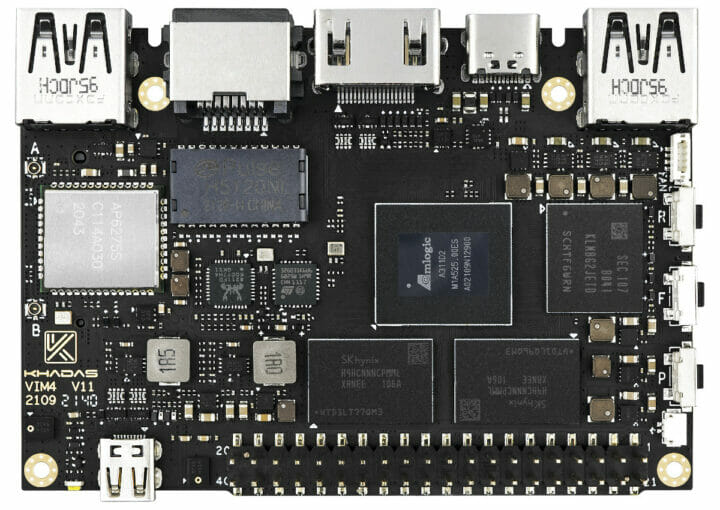
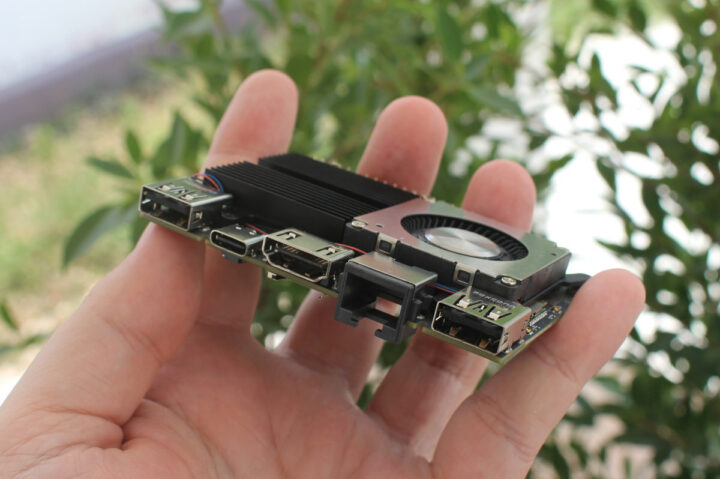
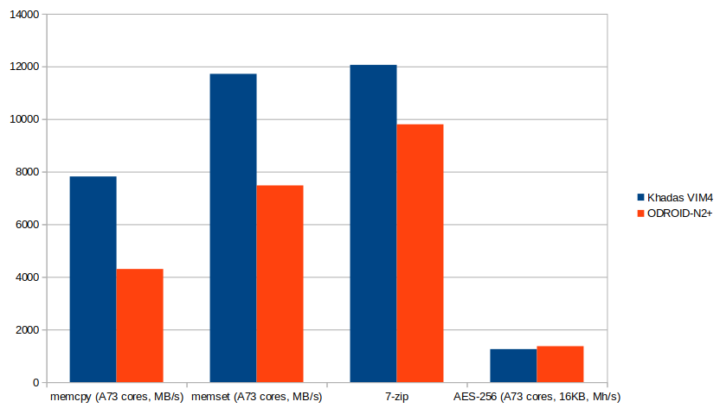
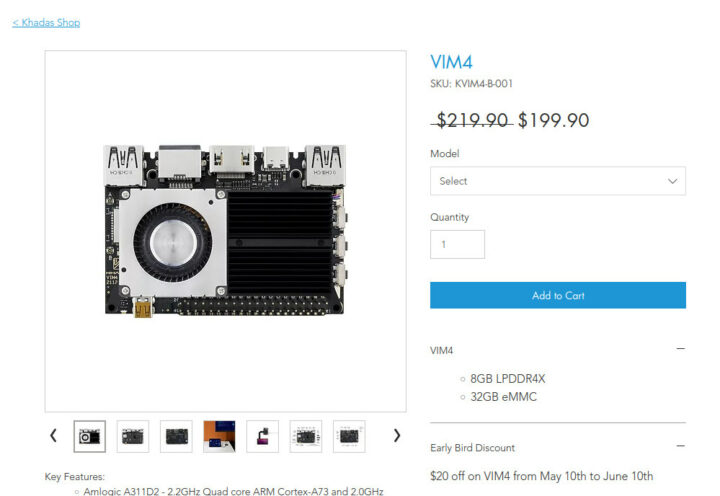



> AES-256 16KB is slower probably because it is a single-threaded benchmark
It is single-threaded and with ARMv8 Crypto Extensions licensed openssl’s aes-256-cbc score scales linearly with CPU clockspeed on same type of ARM cores (A72/A73/Neoverse scoring exactly identical): https://github.com/ThomasKaiser/sbc-bench/blob/master/results/ARMv8-Crypto-Extensions.md
Just a reminder wrt CPU performance and new Amlogic SoCs: maybe scores improve over time since board maker gets better boot BLOBs from Amlogic (hopefully less conservative memory timings, at least higher clockspeeds for the CPU cores).
Both are now at 2400/2015 MHz and both saw a drop in memset memory performance of approx. 20%-25%.
any thoughts why higher cpu clock speeds decrease memory filling with constants, while (reduced/)no value checking in blocks to modify (on comparable page size borders (4kB) for block memory systems and unaligned cache sizes) by that amount?
(reduces bandwidth on system bus (AHB changed bus width 128/256/512b) ?)
(thx)
> any thoughts
Nope. Please remember that we’re talking about BLOBs here. We have no access to the sources of these Amlogic firmware BLOBs that control clockspeeds of ARM cores as well as memory timings. If you look through sbc-bench results focusing on G12B (VIM3 and ODROID-N2[+]) you see variations in memory bandwidth and latency but since we’ve no idea about actual parameters it’s pointless to speculate.
in general: Do we have numbers for AHB bandwidth on Amlogic devices (>128-1024bit) or ARM in general for A73 (A53) cores clusters?
(considering new A76’s, G52 or even G610 getting more capable, this A311D2 G52 is <=0.8GHz now, no NPU’s bw by now and cpu’s clock 2.4Ghz/1.9GHz ~25% difference is what memset bw is reduced (?), x86/x64 memory test (old DDR1, ~2000, for comparison https://media-cdn.ubuntu-de.org/wiki/attachments/05/02/memtest_failure.png and comparable DDR3 (i7 870, ~2010) https://upload.wikimedia.org/wikipedia/commons/5/59/Memtest86-screenshot.png ) for DDR4 memory shows ~100-x000GB/s for L1 caches, so AHB here should be somewhere between 10-x00GB/s for biggest bus width’s)
Ever seen “Memtest” on an aarch64 device?
Check for example Willy’s ramlat utility to get partially a clue about internals. But we need to have in mind that majority of SoCs on popular SBCs are originating from the ‘Android e-waste world’ designed to meet certain criteria often harming performance in certain situations and also often controlled by firmware BLOBs.
See this memory controller example on RK3399.
They don’t define what’s the preferred use case(s) for this board (AFAIK), that’s maybe to be defined by customers for available OS’s, so benchmarking showing top performance capabilities would be most interesting if hardware competes to other top performance devices. On average usage performance limitations might only slightly or even never influence customers experience, handling all bus bandwidth (and latencies, AFAIK) at one time stable and sufficient (for “today’s” software expectations for SBC).
Anyway interesting, thx
As soon as the ROCK5 Model B is released, this will die a very quick death.
Why would it?
ROCK5 Model B will be faster and cheaper with similar features. But software may be the deciding factor here, as Amlogic A311D2 should be pretty stable since it inherits many of the features from A311D, although with enough differences that will make mainline Linux difficult (and I was told nobody is working on upstreaming support).
Rockchip RK3588 is very complex, and it will take a lot of time before it can be considered stable.
> Rockchip RK3588 is very complex, and it will take a lot of time before it can be considered stable.
And this is the big problem with these SBCs.
By the time it’s stable it will be competing with low end Meteor Lake while the 3588 is at most competitive with Jasper Lake and whatever low end AMD might be offering by then.
Any theoretical advantage ARM might offer completely outshadowed by being multiple generations behind in both architecture and node.
> while the 3588 is at most competitive with Jasper Lake
Talking about A311D2 here?
The 3588 actually. In perf/w, and absolute performance it doesn’t trump current Jasper Lake offerings.
Though could have said the same about the A311D2.
There are already RK3588 development boards on sale and tested !
Just search ” RK3588 ” on YouTube. No guess work needed. Just because Radxa use a RK3588 does not make it faster than other RK3588.
Yes, and that performance would have been excellent had they been released in Q1 2020 (when they were first announced) Then it’d have competed with Goldmont Plus (Gemini Lake) chips in the same power/price category. And the RK3588 is better than Gemini Lake chips. But it’s 2022 now. We have Tremont (Jasper Lake) on a 10nm node and a huge IPC increase. Mini-PCs with an N6005 can be had for $200. By the time the RK3588 has some manner of support we’ll have Gracemont (Alder Lake-N), low-end Alder Lake-U and low-end Zen3 in the same price category. And honestly, I… Read more »
Agreed, these developers either need to get the software out with the boards while they are relevant or else they need to lower the price accordingly if release is delayed. I give some grace to Pine because they are trying to release affordable community supported hardware, the others don’t have as much of an excuse. I see ARM boards as quite relevant in the 50 to 150 USD space, once you get above that then you must compete with Intel and AMD with much higher performance. The exception to this is Apple M1 but I doubt these will ever see… Read more »
Well, first sbc-bench result for Firefly ITX-3588J just flew in with broken cpufreq (A55s limited to 915MHz, both A76 clusters limited to ~980 MHz, it seems as with RK3568 there’s a firmware running in the background doing some hidden thermal throttling).
Based on these crippled ‘below 1GHz’ results it’s already obvious that RK3588 is much faster than A311D2.
Agreed. It’s quite pricey. But maybe there’s backer(s) that use their product extensively. Khadas Vim’s has survived in SBC world until now.
The SBC sales are only parts of the business, they also offer design services.
Once I had a video call with somebody that used another SBC company offering a cheaper price for a custom design, but they got plenty of issues, and after switching to Khadas they were satisfied. That’s just an anecdote and YMMV.
I wish they would ship the source code for their mcu. I still remember when they claimed it would be user programmable.
The actual market for these SoC might be better understood by looking what Amlogic say for A311D “Smart VisionSmart Vision enabled by AI technology is the next wave of the industry. On the basis of high-definition video, AI technology is used to upgrade the smart vision SoC, and data can be directly processed at the device side, which greatly reduces the workload of server processing. By performing image analysis locally, and then extracting the useful information from the video such as face recognition, object tracking, and automatic alarm can be easily realized. Amlogic AI smart vision SoC with intelligent analysis… Read more »
I am dissapointed on the price. Too expensive for an SBC.
Same here, $219 is not peanuts..I’ll pass on this board as some of my friends who will also feel the same, they would skip this one as well…Rock5B all the way for me.
Khadas asked me to update some of the specs. There’s no NPU, the RAM frequency is slightly lower, etc…
Any idea whats the idle/normal power consumption for Vim4? Thanks
Yes, but does LGPIO function ok with 40 pin headers?
Well Beelink have a Android TV box based on this SoC, GT-King II.